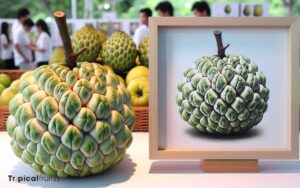How to Grow Custard Apple in Pot? 7 Easy Steps!
To grow custard apple in a pot, select a large container with drainage holes and use well-draining soil. Plant a grafted sapling for best results and place the pot in a sunny location.
Water regularly to keep the soil moist but not waterlogged, and feed the plant with balanced fertilizer during the growing season. Prune to maintain size and shape, and protect from pests and diseases.
Custard apple, also known as sugar apple or Annona squamosa, can be grown in a pot with appropriate care.
Here’s a step-by-step guide:
For example, if you’re growing custard apple in a pot on a balcony, ensure the pot is stable and the location receives ample sunlight, then follow the care
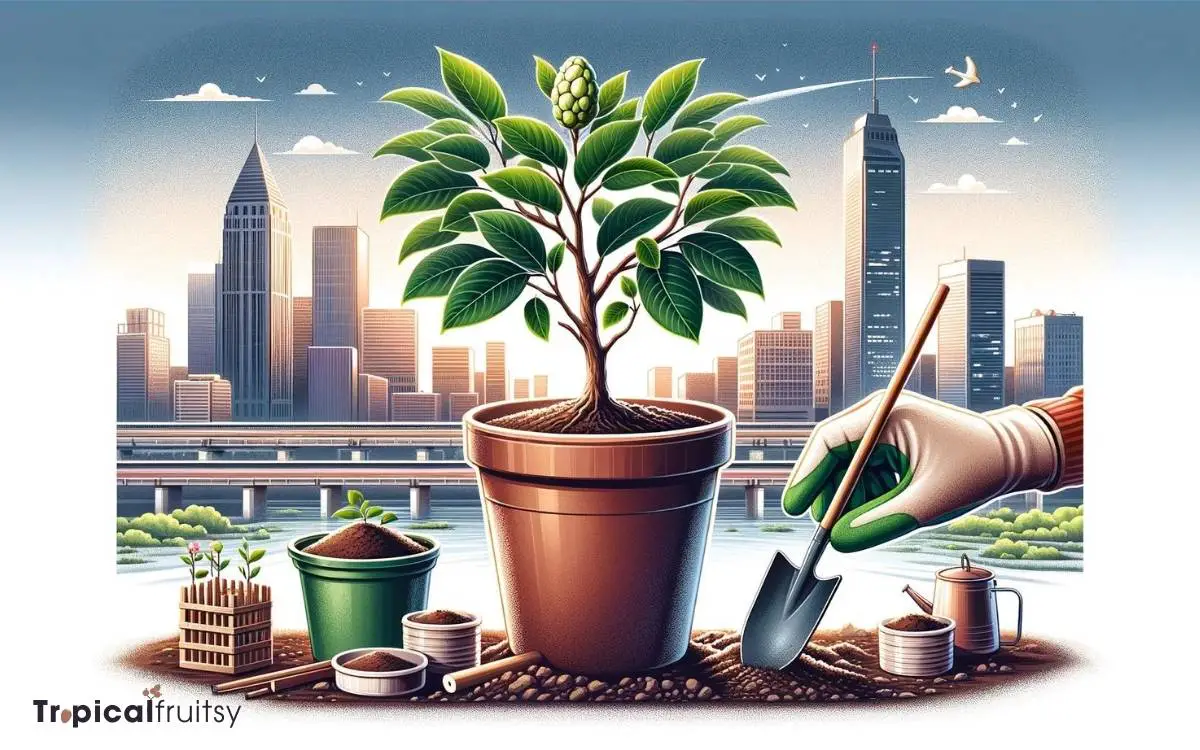
Key Takeaway
Step 1: Selecting the Right Pot
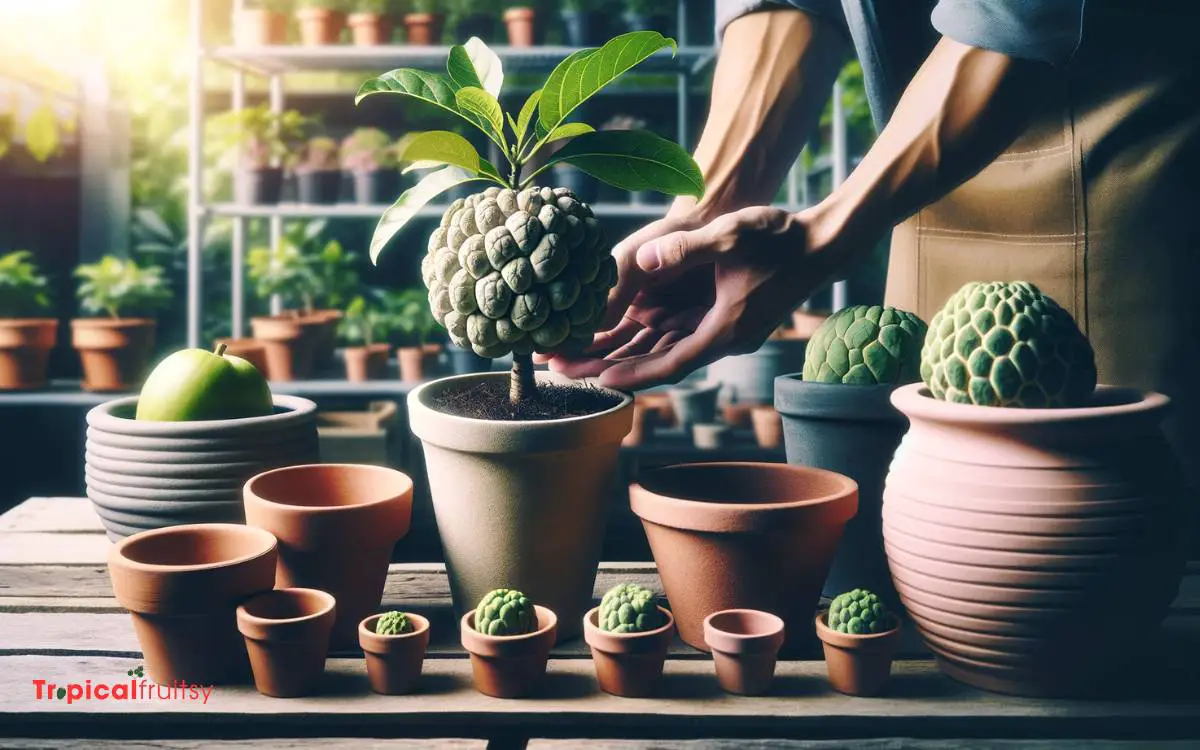
Choosing the right pot for my custard apple tree is crucial, as it must provide ample space for root development and ensure proper drainage. The container’s size directly influences the tree’s overall health and productivity.
Ideally, I select a pot with a diameter of at least 18-24 inches and a similar depth to accommodate the tree’s extensive root system.
Material-wise, I prefer terracotta or glazed ceramic, which offer breathability and stable temperatures. I ensure the pot has several drainage holes to prevent waterlogging, a condition that could lead to root rot.
Additionally, the use of a pot with a detachable saucer aids in the maintenance of optimal moisture levels.
Understanding the importance of the pot’s characteristics, I now turn my attention to the ideal soil composition for nurturing my custard apple tree.
Step 2: Ideal Soil Composition

Now, let’s focus on the ideal soil composition for cultivating custard apples in a pot. It’s crucial to maintain a soil pH level that’s slightly acidic to neutral, as this affects nutrient availability and root health.
Additionally, a high organic matter content is essential for water retention and providing a steady supply of nutrients to your custard apple plant.
Soil Ph Levels
How do I ensure the soil in my pot has the right pH level for growing a healthy custard apple tree? The ideal soil pH for a custard apple tree ranges from slightly acidic to neutral (pH 6.5 to 7.5).
To determine the current pH level, I use a soil pH testing kit which can be easily purchased from a garden center.
Once I have the soil pH reading, if adjustment is necessary, I can amend the soil. For increasing acidity, I might add sulfur or peat moss.
To make it more alkaline, I could use lime. It’s crucial to incorporate these amendments gradually and retest the pH to avoid overshooting the desired range.
Here’s a simple table summarizing the pH adjustment:
| Soil Condition | pH Level | Amendment Needed |
|---|---|---|
| Too Acidic | Below 6.5 | Lime |
| Ideal | 6.5 – 7.5 | None |
| Too Alkaline | Above 7.5 | Sulfur or Peat Moss |
Organic Matter Content
In addition to pH balance, I’m ensuring my custard apple tree thrives by enriching the potting soil with ample organic matter, vital for its growth and fruit production.
Organic matter improves soil structure, which enhances water retention and aeration, both crucial for root development. It also fosters a robust microbial ecosystem, essential for nutrient cycling.
I incorporate well-decomposed compost or aged manure to increase the soil’s organic content, aiming for a blend rich in humus.
Additionally, the presence of organic matter aids in the gradual release of nutrients, which custard apple trees require for optimal growth.
This strategic amendment ensures that my custard apples have a nutrient-dense foundation to support their lifecycle.
Step 3: Planting Custard Apple Seeds
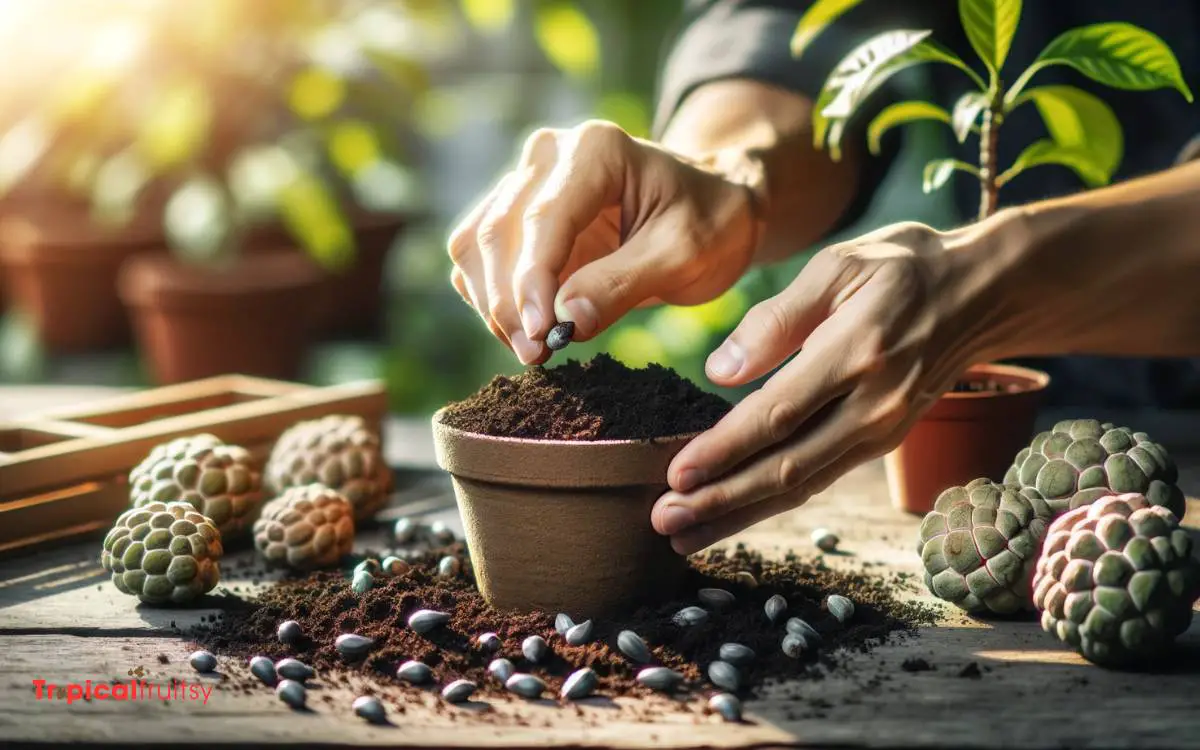
Starting with the selection of healthy, mature custard apple seeds, I’m ensuring the foundation for a successful growth in a pot.
To maximize germination rates, it’s crucial to extract seeds from a ripe custard apple fruit and wash them to remove any pulp, which can inhibit growth due to the presence of germination inhibitors.
After washing, I let the seeds dry for a few days to prevent fungal growth. I then sow the seeds in a well-draining, sterilized potting mix to a depth of about half an inch.
Consistent moisture and warmth are imperative during this stage, but overwatering can be detrimental, leading to rot.
As the seedlings emerge, I’ll need to pay close attention to their moisture needs. This smoothly leads us to understanding watering needs, a critical component for these saplings.
Step 4: Understanding Watering Needs
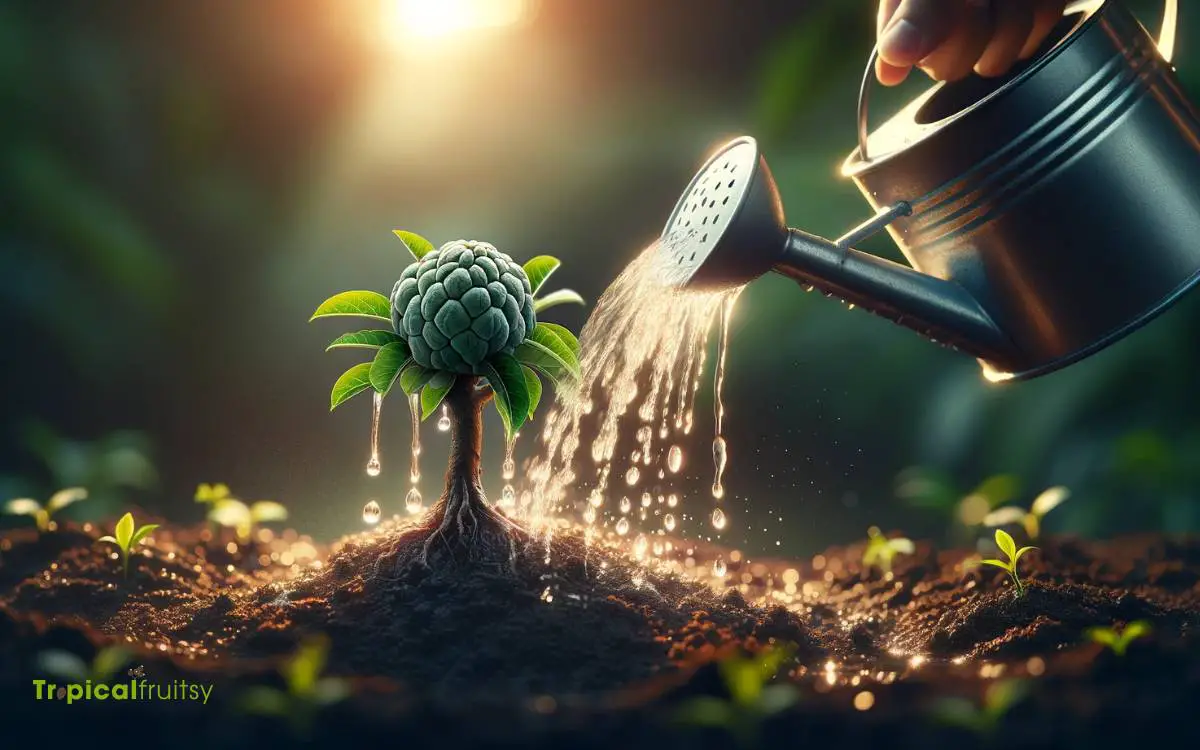
I’ve found that regulating the moisture within the pot is crucial for the thriving of custard apple seedlings. These plants require consistent and adequate hydration to facilitate their delicate growth process.
However, overwatering can lead to root rot, a detrimental condition caused by fungal pathogens thriving in overly moist environments. Underwatering, on the other hand, can stress the plant, leading to wilting and reduced vigor.
To keep the audience engaged, consider these vital pointers:
- Consistent Moisture: Maintain evenly moist soil, avoiding the extremes of waterlogged conditions and dryness.
- Drainage: Ensure the pot has adequate drainage holes to prevent water accumulation.
- Monitoring: Check soil moisture regularly using a finger or moisture meter to guide your watering schedule.
Step 5: Fertilizing Your Custard Apple
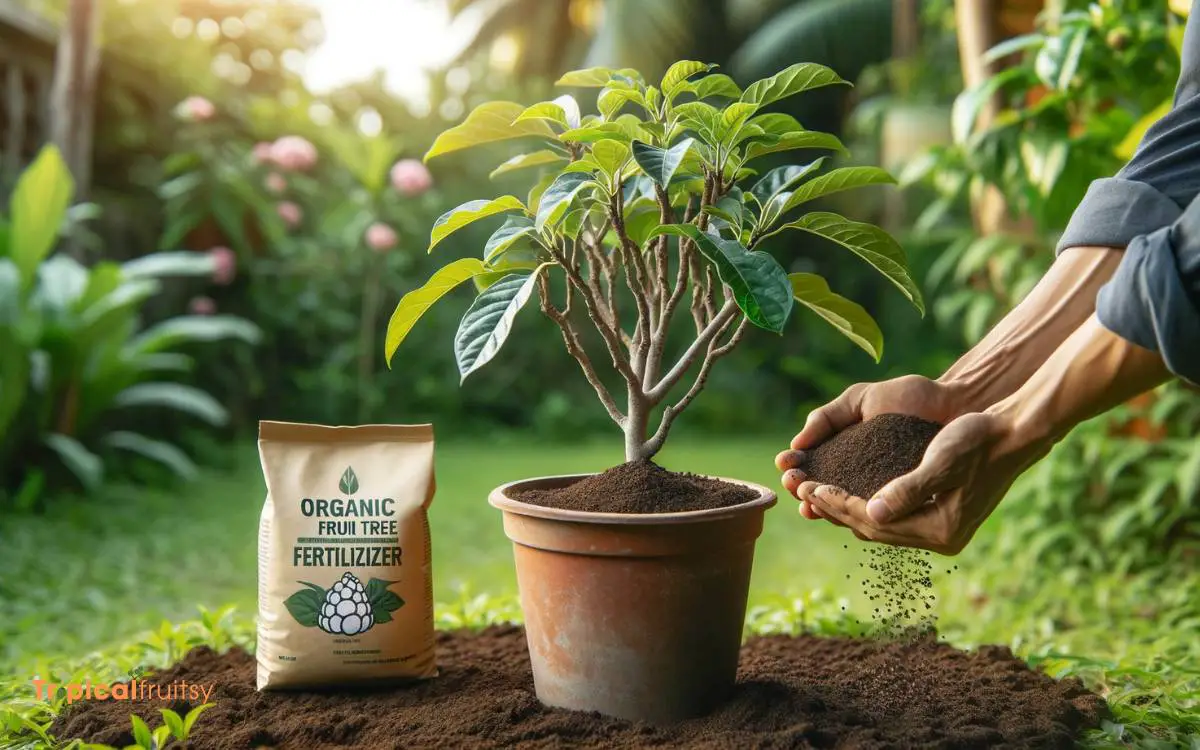
Now, I’ll turn my attention to the critical aspect of fertilization, which is paramount for the thriving growth of a custard apple plant in a pot.
I’ll examine the most effective fertilizer types that supply the essential nutrients required for its development.
Moreover, I’ll outline a seasonal feeding schedule to ensure that the plant receives the right amount of nourishment at the optimal times of its growth cycle.
Optimal Fertilizer Types
When choosing fertilizers for my custard apple plant in a pot, I ensure they’re rich in phosphorus, potassium, and nitrogen to promote healthy growth and fruit development.
These three elements are crucial:
- Phosphorus (P): Essential for the transformation of solar energy into chemical energy, it supports root development and flowering.
- Potassium (K): Regulates photosynthesis and water uptake, fortifying the plant against diseases and aiding in fruit quality.
- Nitrogen (N): Critical for vegetative growth, nitrogen drives the synthesis of proteins and chlorophyll.
Seasonal Feeding Schedule
Transitioning from selecting the right fertilizer, I’ll now outline a seasonal feeding schedule to ensure my custard apple plant receives the nutrients it needs throughout the year.
In spring, as active growth commences, I apply a balanced, slow-release fertilizer rich in nitrogen to promote foliage development. I’ll repeat this process every six weeks until late summer.
As the fruit sets and matures, I switch to a phosphorus-enhanced formula to support root development and fruit production.
During the fall, potassium is crucial to aid in the ripening of fruits and strengthening of the plant before dormancy.
I reduce feeding in winter, focusing on maintaining soil health with minimal nitrogen to prevent new growth susceptible to cold damage.
Step 6: Pruning and Maintenance

I’ll ensure my potted custard apple tree thrives by regularly pruning and maintaining it. Pruning isn’t just about shaping; it’s a vital practice that promotes healthy growth and fruit production.
I’m particularly focused on three key aspects:
- Selective Pruning: I remove dead or diseased branches to prevent the spread of pathogens and to redirect energy to healthy growth.
- Air Circulation: By thinning out dense areas, I improve airflow, which is crucial in mitigating fungal infections.
- Sunlight Penetration: Ensuring that light reaches the inner canopy aids in photosynthesis throughout the tree, essential for vigor and yield.
By adhering to these principles, I significantly enhance the tree’s vitality.
Step 7: Managing Pests and Diseases
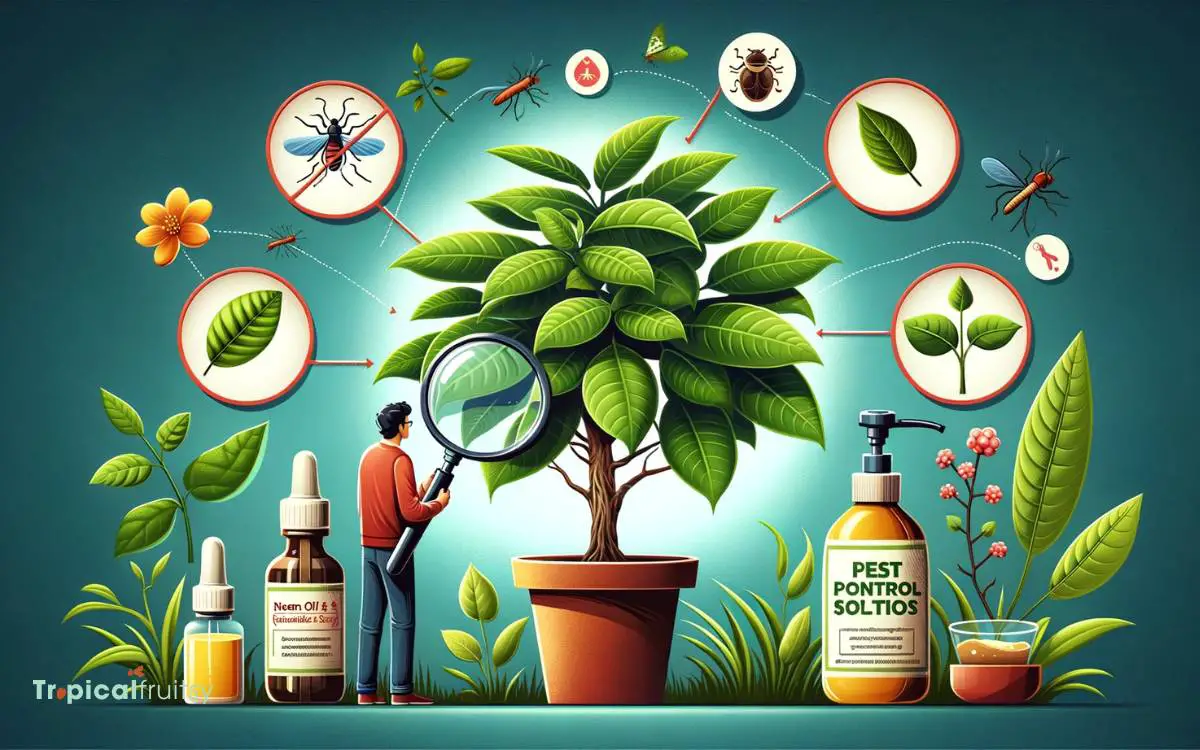
After establishing a routine for pruning and maintenance, it’s vital I now turn my attention to the prevention and treatment of pests and diseases that can affect my potted custard apple tree.
Vigilance is key; I must regularly inspect my tree for signs of infestation or illness. It’s crucial to identify issues early to manage them effectively.
Here’s a table summarizing common threats and control measures:
| Pest/Disease | Control Measure |
|---|---|
| Aphids | Neem oil or insecticidal soap sprays |
| Scale insects | Horticultural oil or manual removal |
| Mealybugs | Alcohol swabs or biological control agents |
| Anthracnose | Fungicidal sprays and proper sanitation |
| Root rot | Well-draining soil and careful watering |
I ensure I’m using the right treatment for the right problem, always adhering to the label’s instructions and safety precautions.
Encouraging Fruit Production

To boost my custard apple tree’s fruit production in a pot, I’m focusing on optimal pollination, fertilization, and appropriate sun exposure.
Encouraging fruit formation in this species involves understanding the plant’s reproductive needs and catering to them precisely.
- Pollination: Hand pollination can vastly improve fruit set since natural pollinators might be scarce. I use a fine paintbrush to transfer pollen from flower to flower.
- Fertilization: A balanced, slow-release fertilizer with higher phosphorus content supports flowering and fruiting. I apply this in the recommended amounts during the growing season.
- Sunlight: Custard apple trees require ample sunlight to produce energy for fruit development. I ensure my potted tree gets at least six hours of direct sunlight daily.
Can I Use the Ripe Custard Apples to Plant and Grow More in a Pot?
Yes, you can use ripe custard apples to plant and grow more in a pot. To do so, first, remove the seeds from the ripe custard apple fruit. Then, clean and dry the seeds before planting them in a pot filled with well-draining soil. Follow these steps to learn how to ripe custard apple.
Overwintering Custard Apple Trees
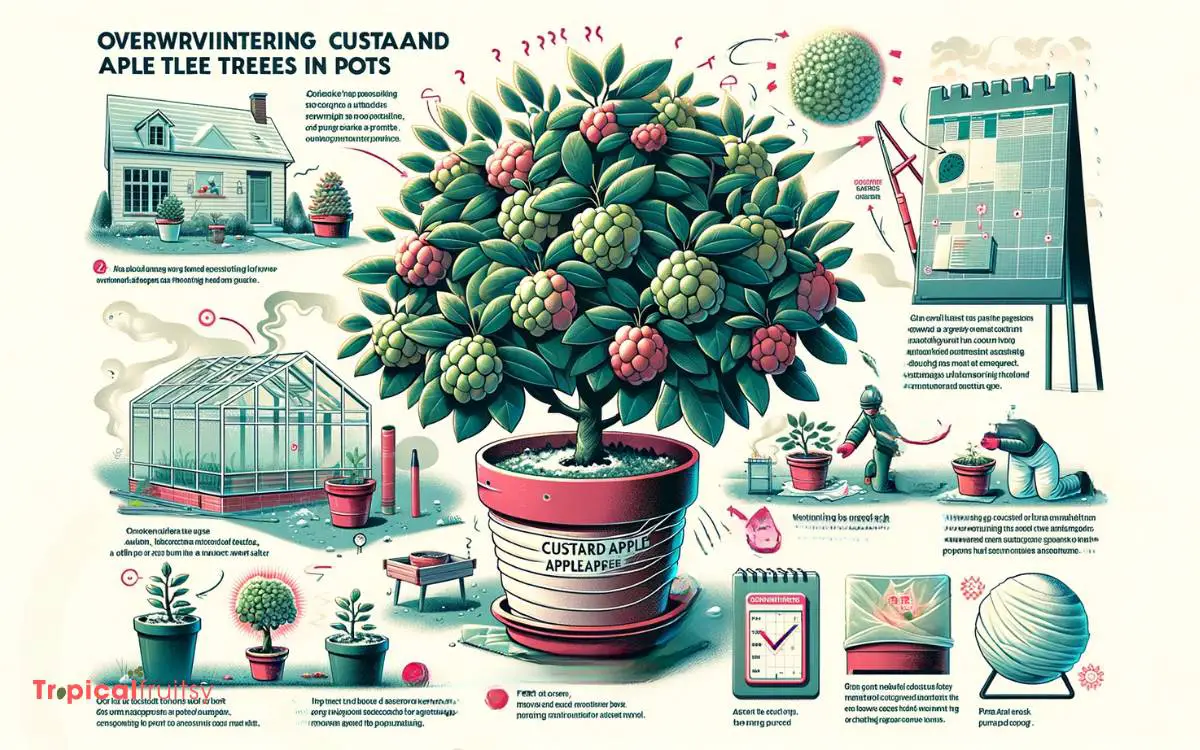
As winter approaches, I’m preparing my potted custard apple tree for the colder months by adjusting its care routine.
This tropical species, Annona squamosa, is sensitive to cold temperatures. Hence, it’s crucial to ensure the tree isn’t exposed to frost or freezing conditions.
I’ll relocate my tree to a well-insulated indoor space where temperatures remain between 15-25°C, simulating its natural habitat.
During overwintering, I reduce watering frequency, allowing the soil to dry out slightly between irrigations to prevent root rot.
I also cease fertilization, as the plant enters a dormancy phase and excess nutrients can accumulate, potentially harming the tree.
Monitoring humidity levels is essential; dry indoor air can stress the tree, so I’ll provide occasional misting to maintain adequate moisture.
Can Custard Apple Trees Be Grown in Pots

Yes, custard apple trees can be grown in pots or containers, but it’s important to choose the right size of container and provide proper care to ensure the tree thrives.
Here are some steps to consider if you want to grow a custard apple tree in a pot:
Container Selection:
- Choose a large and sturdy container with good drainage. A pot with a minimum diameter of 24 inches (60 cm) or larger is recommended to accommodate the growing tree and its root system.
- Ensure the pot has drainage holes at the bottom to prevent waterlogging, which can lead to root rot.
Soil Mix:
- Use a well-draining potting mix suitable for fruit trees or citrus plants. A mix of loam, compost, and perlite or sand can work well.
- Make sure the soil is rich in organic matter and slightly acidic with a pH level between 6.0 and 7.0, which is suitable for custard apples.
Planting:
- Plant your custard apple tree in the pot at the same depth it was previously planted in a nursery container.
- Water the tree thoroughly after planting to settle the soil and eliminate air pockets.
Sunlight:
- Custard apple trees require full sun to thrive. Place the potted tree in a location where it will receive at least 6-8 hours of direct sunlight each day.
Watering:
- Keep the soil consistently moist but not waterlogged. Water the tree when the top inch (2.5 cm) of soil feels dry to the touch.
- Watering needs may vary depending on the climate and season, so monitor the soil moisture regularly.
Fertilization:
- Fertilize the custard apple tree with a balanced, slow-release fertilizer suitable for fruit trees. Follow the manufacturer’s instructions for application.
- Fertilize during the growing season (spring and summer), and reduce or cease fertilization in the winter.
Pruning:
- Prune the tree to maintain its shape and remove any dead or diseased branches.
- Pruning can also help control the size of the tree and encourage fruit production.
Pollination:
- Custard apple trees are typically self-pollinating, but having multiple trees or hand-pollinating the flowers can increase fruit production.
Repotting:
- As the custard apple tree grows, it may outgrow its pot. You may need to repot it into a larger container every few years to accommodate its expanding root system.
Pest and Disease Control:
- Monitor the tree for pests and diseases and take appropriate measures to control them. Common pests may include aphids, scale insects, and fruit flies.
Growing a custard apple tree in a pot can be a rewarding experience, allowing you to enjoy this delicious fruit even in limited garden spaces. With proper care, your potted custard apple tree can produce fruit for many years.
Conclusion
Well, after meticulously tending to my potted custard apple tree, like a mad scientist in a green lab coat, I’ve learned a few tricks.
If you cherish wrestling with pests, praying for fruit, and chatting with your tree about the importance of overwintering, then this is the hobby for you.
It’s a horticultural odyssey, truly. Just remember, growing custard apples in pots is a test of patience and wit—and don’t you forget to laugh when nature decides to throw a curveball.





